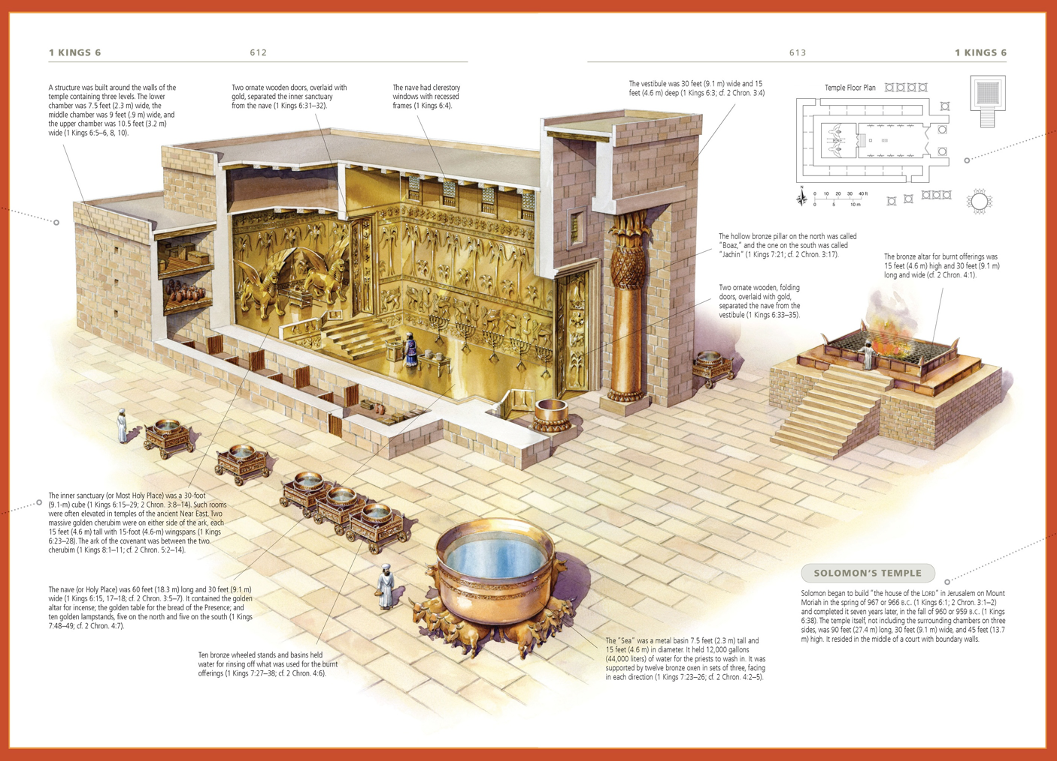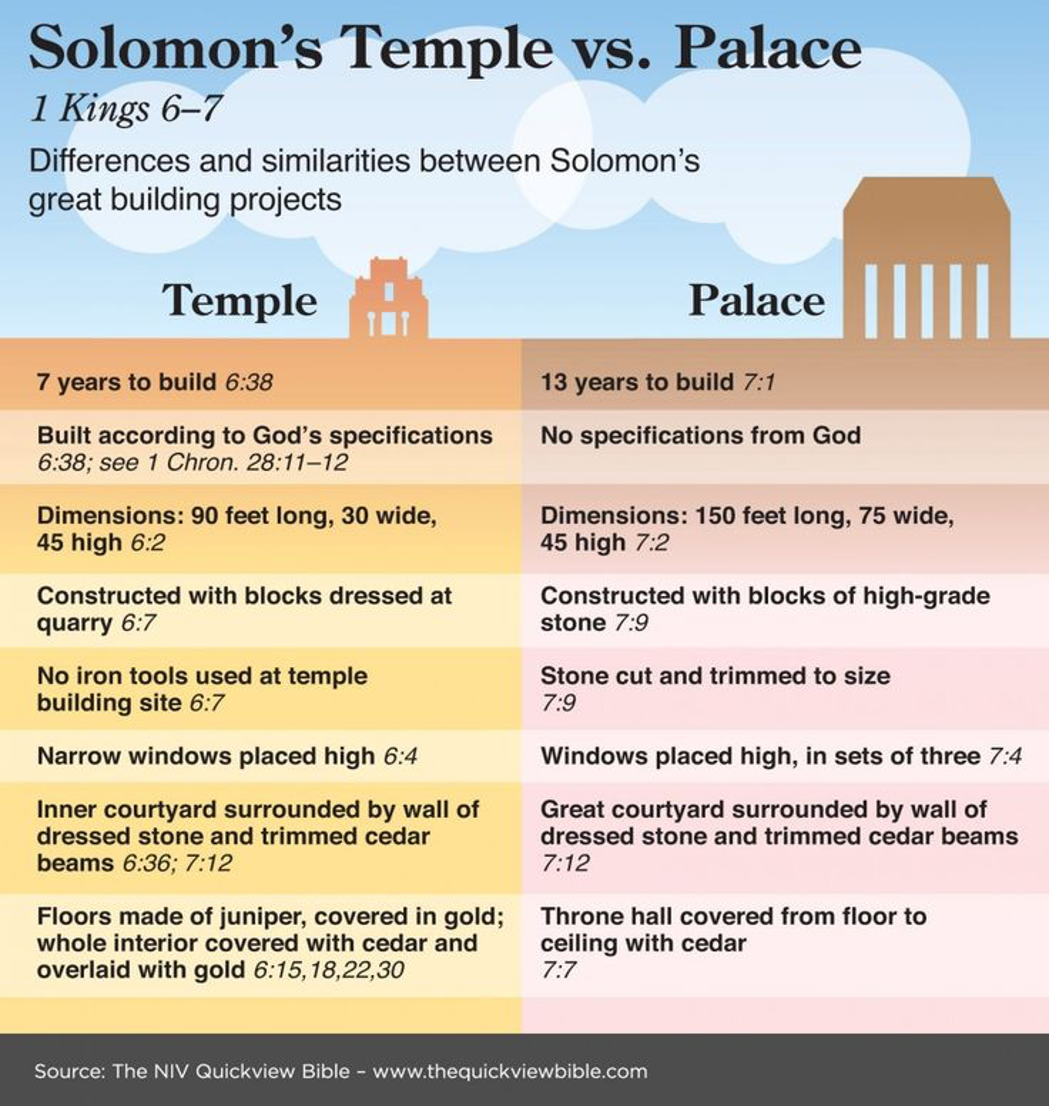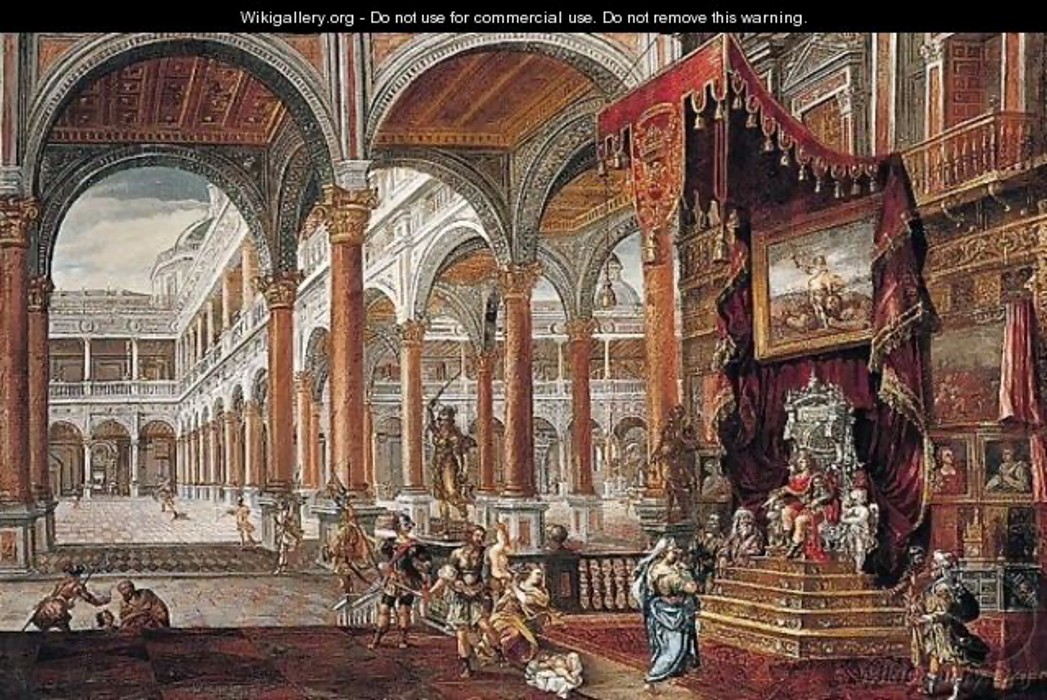Questions
Day 1
Scriptural Reflection
1 Kings 6:1–38
This week, we shall continue the
study of the book of 1 Kings in the Old Testament.
This is a lengthy chapter about the temple built by
Solomon. It is most helpful to read it with
reference to the diagram below. I
shall attempt to list the main measurements in “feet” (1 cubit roughly = 1.5
feet), in the verses that I have highlighted for reflection:

6:1-10—The Main Structure of the Temple
(1) The year that Solomon began building the temple is believed to be 967/6 B.C.
a. What might be the significance of highlighting the time of the building of the temple with reference to Exodus?
b. What is the most significant symbol of the temple of the Lord to Israel?
(2) The specified measurements of the building and its parts are as follows:
|
|
Length |
Width |
Height |
|
Temple itself |
90’ |
30’ |
45’ |
|
The Portico |
20’ |
30’ |
|
|
Side rooms-lower |
|
7.5’ |
7.5’ |
|
Side rooms-middle |
|
9’ |
7.5’ |
|
Side rooms-upper |
|
10.5’ |
7.5’ |
(3) The side rooms are obviously not considered the “Holy Place” as such: What might be the significance of making sure they were built without any insertion into the temple walls themselves? (v. 6)
(4) What is the significance of ensuring the blocks were dressed (i.e. cut and hewn to their exact specification) at the quarry so that no iron tools would be used (to maintain the least amount of noise at the temple site)?
6:11-13—God’s Reminder to Solomon
(5) How does this reminder to Solomon serve to emphasize what the most important symbol of the temple is to Israel?
(6) Does the presence of the temple automatically signify God is “living among the Israelites”?
6:14-18—Only Cedar Used
(7) Before describing the Most Holy Place in greater detail in vv. 19-28, it is emphasized that the “inside of the temple”—i.e. both the inner sanctuary (the Most Holy Place) and the main hall (the Holy Place)—were all wood (cedar), and “no stone was to be seen”: What might this emphasis point to? (v. 18)
6:19-28—The Most Holy Place
|
|
Length |
Width |
Height |
|
Temple itself (v.2) |
90’ |
30’ |
45’ |
|
The Main Hall (v.17) |
60’ |
30’ |
45’ |
|
The Inner Sanctuary |
30’ |
30’ |
30’ |
(8) The emphasis of the decoration of the Most Holy Place is that it was overlaid with “pure gold” in v. 20 (this is understandable); but why does the Bible mention also that the altar of cedar (i.e. the altar of incense) was also overlaid with it? (See the special significance attached to the altar of incense in Exodus 30:6; 40:5 and special rendering of its location by the author of the book of Heb. in 9:4)
(9) The two cherubim were 7.5’L x 15’W x 15’H: What is the significant symbol of these two cherubim? (see Gen. 3:24; Exod. 25:20; Isa. 37:16 and Heb. 9:5)
6:29-37— Interior Decoration and Doors
(10) One repetition of the interior decoration is the carving of cherubim, palm trees and open flowers (6:29, 32 and 35). Read Psalm 92:12 to see how the psalmist was particularly inspired by the palm trees as he worshipped in the temple on the Sabbaths.
(11) The temple, for all intents and purposes, was not a very large building, but considering the manpower, the materials and the length of time consumed for its construction, what do you think about God’s desire and purpose of its construction?
(12) What is the main message to you today and how may you apply it to your life?
Day 2
Scriptural Reflection
1 Kings 7:1–51
It is a lengthy chapter except that the bulk of it concerns the materials and items of the temple (vv. 15-50). I shall only highlight a thought or two for reflection in each division of the chapter:
7:1-12—The Building of Solomon’s Palace
(1) In the middle of describing the construction
of the temple of God, the Biblical author chooses to insert here a brief
description of the palace that Solomon built for himself. Based on the
following chart of comparison, what might be the reason(s) for the insertion of
a description of Solomon’s palace here?

(2) The following is Francisco Gutierrez
rendering of Solomon’s Hall of Justice. Though not painted strictly according to the biblical account, in what
ways does it succeed in depicting Solomon’s Palace?

7:13-50—The Temple’s Furnishings
(3) Vv. 13-14: Hiram, the “bronze” artisan from Tyre
a. What might be the reason for explaining the origin of Hiram, the artisan from Tyre?
(4) Vv. 15-22: The bronze pillars of the porch (see diagram of previous day) — The measurement is 27’H, and 18’ in circumference and the top capitals are 7.5’ H.
a. See the detailed work that will go into their construction: Why should even the bronze pillars be so elaborately decorated?
(5) Vv. 23-26: The bronze sea (see diagram of previous day)—45’ in circumference and 7.5’H:
a. What was the sea (or basin) used for? (See 2 Chr. 4:6; Exod. 30:18ff)
b. What might be the symbolic significance of having 12 bulls supporting this basin preparing the priests for service? (Note that bulls were the costliest animals used in sacrifice.)
(6) Vv. 27-39: The brazen wheeled stands and their basins—6’L x 6’W x 4.5'H
a. We have seen from 2 Chronicles 4:6 that while the bronze sea was provided for the priests to wash themselves in preparation to approach the altar to offer sacrifices, what then were the ten basins for?
b. Some of the decorations of the stands resemble that of the walls of the temple (cherubim, palm trees and flowers). What might be the symbolic meanings of bulls and lions?
(7) Vv. 40-51: Summary of vessels—Apart from the bronze objects already mentioned, golden objects were added plus the booty consecrated by David to the sanctuary (see 2 Sam. 8:7, 11, 12; 1 Chr. 18:7, 10, 11).
a. What might be the reason(s) for such a detailed record of the making of these objects of the temple?
(8) What is the main message to you today and how may you apply it to your life?
Day 3
Scriptural Reflection
1 Kings 8:1–21
Since the temple was completed on the 8th
month of Solomon’s 11th year of reign (1 Ki. 6:38), he waited 11
months to dedicate the temple which coincided with several great festivals held
on the 7th month (see Num. 29):
(1) Where was the ark moved from and where was it now re-united with the new dwelling of the Lord? (see 2 Chr. 3:1)
(2) The ark was separated from the Tabernacle since the time of Eli (1 Sam. 4:17); it was not reunited with the Tabernacle even during the reigns of Saul and David. How did the people now celebrate its return? (v. 5) How would you feel if you were one of the priests?
(3) Previously the transportation of the ark brought calamities (1 Sam. 6:19; 2 Sam. 6:7). Do you think the priests had much fear this time? What was the outcome? Why?
(4) V. 9 states that “There was nothing in the ark except the two stone tablets”. If we take this statement at face value (and there is no reason not to), does it matter that the urn of manna (Exod. 16:33), and Aaron’s budded staff (Num. 17:10) were missing from it? Why or why not?
(5) How did the Lord affirm His pleasure in dwelling in Solomon’s temple? (See also Deut. 4:11; 5:22ff; Exod. 40:34ff.)
(6) As God affirmed His presence and His delight, and before Solomon uttered his great prayer, he made a public acknowledgement to his people (vv. 14-21):
a. What did he acknowledge by referring to God’s promise to his father, David?
b. What did he acknowledge as the two purposes of the building of this temple? (vv. 20-21)
(7) What is the main message to you today and how may you apply it to your life?
Day 4
Scriptural Reflection
1 Kings 8:22–30
This lengthy prayer can be divided into the following parts: Invocation (vv. 23-30); Intercession (1st Request vv. 31-32; 2nd request vv. 33-34; 3rd request vv. 35-36; 4th request 37-40; 5th request vv. 41-43; 6th request vv. 44-45; 7th request vv. 46-51); Basis of Confidence (vv. 52-53) and Benediction (vv. 54-61). Today, we shall reflect on his Invocation.
(1) If our prayers are always focused on asking, without “adoration” (i.e. in praising God for who He is and what He has done), consider the outcomes.
a. What kind of a prayer life will we develop?
b. What kind of a Christian will we become?
(2) Solomon’s adoration (vv. 23-24):
a. Who God is: How did he praise and adore God in v. 23?
b. What God has done: With what did he justify his words of adoration? (vv. 23-24)
c. How did this opening adoration serve as a foundation to the rest of his supplication?
(3) Based on who God is and what He has done, what personal request did he make? (vv. 25-26)
(4) Of all the things he could have asked, why was it the only and first thing he asked?
(5) Solomon continued his adoration in v. 27:
a. What was the context of this adoration?
b. What was the essence of this adoration?
(6) Based on this adoration, what did Solomon ask for in vv. 28-30 in a nutshell?
(7) What is the relationship between the adoration in v. 27 and the petitions of vv. 28-30?
(8) Based on his petitions in vv. 28-30, what was the primary function of the temple to Solomon? (See Isa. 56:7; Matt. 21:13)
(9) Should it still be the primary function of a church (and its building) today? Why or why not?
(10) What have you learned from this invocation and how may you apply it to your prayer- life?
Day 5
Scriptural Reflection
1 Kings 8:31–51
(1) 8:31-32: Wronging One’s Neighbor (civil justice)
a. When one is accused of wrongdoing against his neighbor (as referred to in Exod. 22:6-12) and he comes before the temple denying the charge, what did Solomon ask God to do?
b. Would God necessarily condemn or vindicate immediately? Why or why not?
c. How important was this prayer to Solomon and the people?
(2) 8:33-34: Defeat with some taken captive (as referred to in Lev. 26:17; Deut. 28:25)
a. Do you think every time the people were defeated that it was necessarily because of their sin?
b. What would their repentance entail? (v. 33)
c. What did Solomon ask God to do?
d. How important was this prayer to Solomon and the people?
(3) 8:35-36: Drought (as referred to in Lev. 26:19; Deut. 11:17; 28:23)
a. Do you think drought can still be a consequence of our sin?
b. What would repentance entail?
c. What did Solomon ask God to do?
d. How important is this prayer for us today?
(4) 8:37-40: Plague and Natural Disasters (as referred to in Lev. 26:19, 20, 26; Deut. 28:20-22)
a. How many would it take to intercede for the entire nation?
b. What did Solomon ask God to do?
c. How may you apply this prayer today?
(5) 8:41-43: Foreign Worshipper (as referred to in Num. 15:14-16)
a. Why did Solomon choose to pray for foreign worshippers at this dedication ceremony?
b. How does this reflect his agreement with Isaiah 56:6-7 and Mark 11:17?
c. How does this reflect the desire of God in His covenant with Abraham? (Gen. 22:18)
(6) 8:44-45: Going to War
a. What condition was attached to such a war? (v. 44)
b. How important was it?
c. What did Solomon ask God to do?
(7) 8:46-51: In Captivity (as referred to in Lev. 26:33, 44; Deut. 28:45ff, 64ff; 30:1-5)
a. From the words he said, do you think Solomon did anticipate their exile? (v. 46)
b. Since they would be in exile in a foreign land, how could they pray in the temple? (v. 48)
c. What did Solomon ask God to do?
d. Can you remember who prayed exactly according to the request of Solomon while Israel was in exile? (See Daniel 9)
(8) In all these intercessions...
a. ... did Solomon recognize where God really dwells? (8:34, 36, 39, 43, 45, 49)
b. What then is the significance of the temple? (8:29)
(9) What is the main message to you today and how may you apply it to your life?
Day 6
Scriptural Reflection
1 Kings 8:52–66
8:52-53—Concluding Prayer
(1) As Solomon concluded his intercession, what was the basis of his confidence that God would open His eyes to see and would hear their cry? (v. 53)
(2) How might this help your confidence in your prayer? (see 1 Pet. 2:9)
8:54-61—Benediction
(3) What do you understand by “benediction”?
(4) What does it mean to you?
(5) The “Benediction” of Solomon was basically in two parts:
a. Part 1—Solomon gives praise to God for two reasons:
- The Rest of His people: In what sense had God given them rest at that point? (see Ps. 95:8-11)
- The fact that not one word (of His promises) has failed: Can you say the same about God’s promises to you? Why or why not?
b. Part 2—Solomon expresses his wishes in the form of blessings marked by the word, “may”:
- May God be with them (v. 57): How did Solomon frame this particular blessing?
- May He turn their hearts to Him (v. 58): Was it the same as the final blessing in v. 61? What was the emphasis here?
- May his prayer be near to God day and night (v. 59a): How does this blessing express Solomon’s deepest desire in his prayers?
- May God uphold his cause and that of His people (v. 59b): What might be the cause(s) Solomon had in mind? Why did he say, “according to each day’s need”?
- May the people of the earth know (v. 60): Do you think that the key to the nations knowing God is God’s hearing their prayers or their obedience to God? Why?
- May their hearts be fully committed to the Lord (v. 61): How does this blessing answer our preceding question?
8:62-66—Dedication of the Temple
(6) It is helpful to remember that the 7th month was a significant month for festivals: With the 1st day being the Festival of Trumpets, the 10th day the Day of Atonement and the 15th – 21st days the Festival of Tabernacles. Since the feast for the dedication of the temple was celebrated for “seven days more”, it could have been held right after the Festival of the Tabernacles (it would be inconceivable to ignore the observance of the Day of Atonement — see Num. 29):
a. The focal point of the celebration was obviously the temple (and God Himself) and secondarily the king who built it. How does the whole passage end in v. 66?
b. What did this dedication of the temple mean to the people?
(7) What is the main message to you today and how may you apply it to your life?
Day 7
Scriptural Reflection
1 Kings 9:1–9
(1) What was the occasion at Gibeon when God first appeared to Solomon? (1 Ki. 3)
(2) Apart from granting his request for wisdom, what did God caution him about? (1 Ki. 3:14)
(3) Although “Solomon awoke — and he realized it had been a dream" (3:15), what does the Bible say about this dream here? (9:1-2)
(4) Judging from what God said in v. 3, what was the purpose of this second appearance?
a. Was his prayer of dedication just wishful thinking on his part?
b. How did God answer his prayer?
- What is meant by “consecrated this temple"?
- What is meant by “My eyes and my heart will always be there”?
(5) What was the additional personal blessing that God promised Solomon? (v. 5) How much, do you think, it meant to Solomon?
(6) What conditions did God put on His blessings? (v. 4) Why?
(7) What curses would befall him and his people should he or his descendants turn away from the Lord? (vv. 7-9)
(8) Why did God choose to warn him at this point?
(9) What eventually would happen to Solomon? (1 Ki. 11:4)
(10) What eventually would happen to the people and the temple? (2 Ki. 24:3-4; 25:8-9, 21)
(11) “All who pass by” (v. 8) obviously refers to the Gentiles: What would they say? How would they know?
(12) What is the main message to you today and how may you apply it to your life?